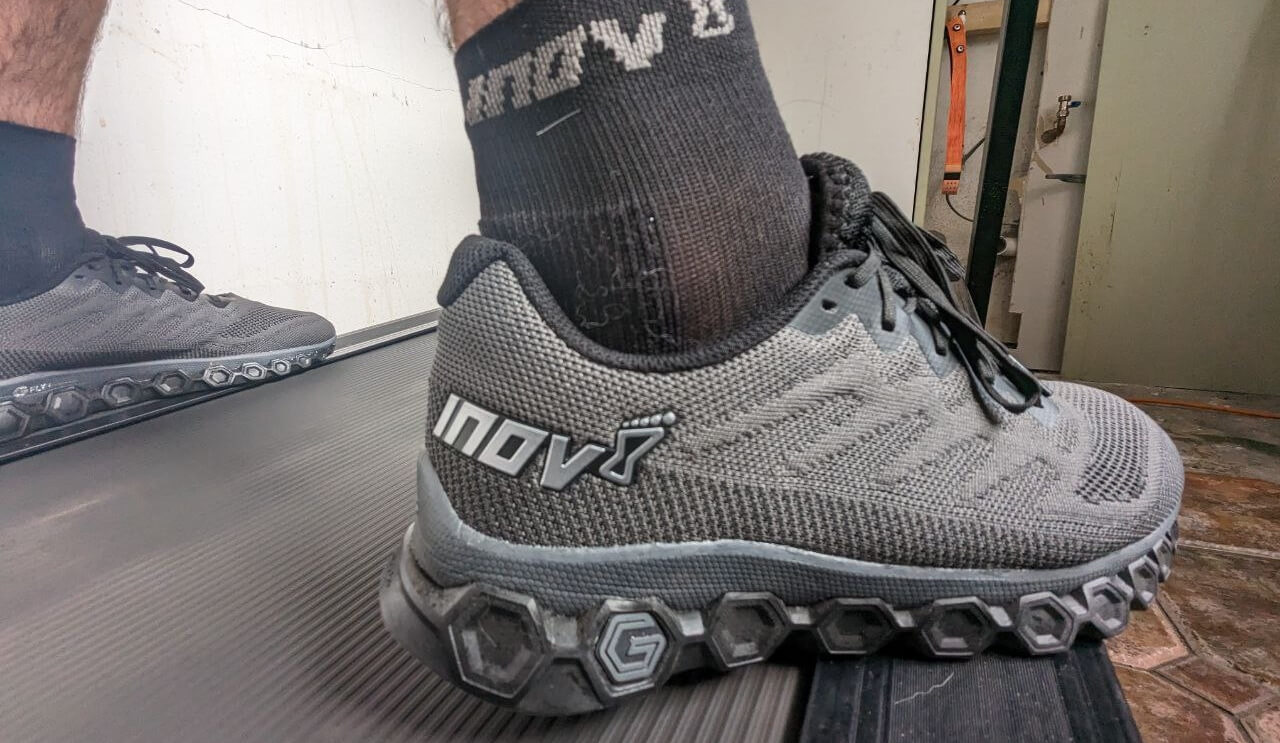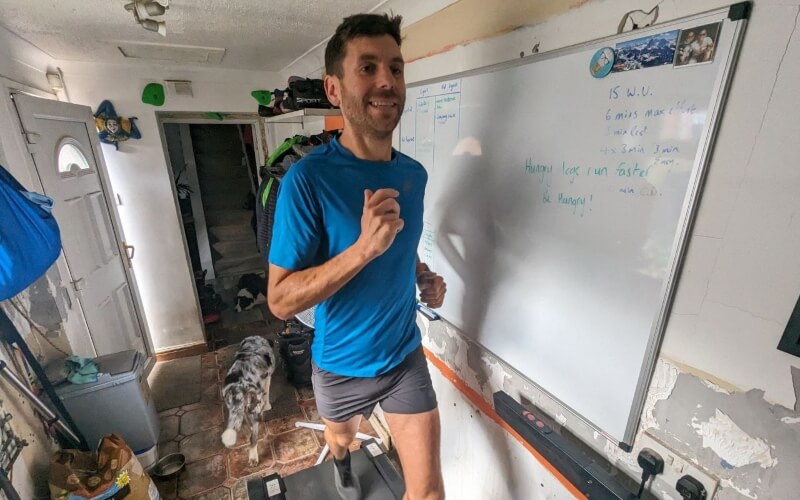
Andy Berry is a British ultrarunner who has had an extremely successful 2023. In May he broke the Lake District 24-Hour Fell Record – summiting 78 peaks in 23 hours 23 mins. He then followed that up by winning the Lakeland 100 ultramarathon in July.
What you may not know though, is that Andy does a lot of his training on the treadmill! In this article he gives you his top tips for treadmill running, as well as his three favourite treadmill hill workouts.
So many runners hate the thought of hitting a treadmill for their workout, but I have never fully understood why. In my opinion, every runner could get something out of using a treadmill in their training.
While you can’t compare treadmill running directly to running freely through the mountains or trails, it is a tool that can help prepare your body to go a bit further or a bit faster.
For the purposes of this article, I will concentrate on using a treadmill to build hill strength, as that’s what I mainly use it for. I will share three treadmill workouts that I have used historically through my running career.
It’s important to remember that you should train for where you are at fitness-wise and not where you want to be. That doesn’t mean you won’t get there, but there are no short cuts that can avoid the simple truth: it’s all about hard work and consistency.
WHY SHOULD RUNNERS USE THE TREADMILL?
Although as a relative flat land resident I require a treadmill to prepare me for the big mountain races and challenges I enjoy, I wouldn’t get rid of my treadmill even if I lived in the big hills I love so much. Here are my top 3 reasons for that:
- Specificity – Even the longest hills in Britain wouldn’t allow me to do long repetitions without too large a period of recovery after each to get back down.
- Control – The use of a treadmill allows you control over nearly everything: pace, incline, climate, nutrition, hydration, etc. This controlled environment allows you to precisely monitor your progression.
- Reliability – The impact of weather or life balance is taken out of the equation. You know how long a session will take and build that time into your day, at a time to suit you. No daylight or weather check required.
ANDY’S WARM-UP FOR TREADMILL RUNNING
We all know we should warm up properly and thoroughly. But if it’s a cold day we tend to end up just jogging to where we are going to work out, and then just do the session, right? Come on, be honest! Having control on the climatic and time conditions with a treadmill workout allows you to build in a proper warm-up.
Here is my normal warm-up routine before a treadmill session:
- One mile easy jog at 1% incline
- 15 Squats into calf raises / 10 forward lunges / 10 rear lunges / 10 lunges with twists / leg swings forwards and sideways for 30 seconds on each leg
- One mile starting easy but building to moderate pace by the end

3 TREADMILL HILL WORKOUTS FOR RUNNERS
1. Treadmill Vertical Kilometre
When I first started to explore the world of ultrarunning, my training path would cross sometimes with Jim Mann who also lived in County Durham at that time. He introduced me to the idea of the treadmill vertical kilometre (VK). While my training has evolved since then, I still think it’s a fun "game" to play on the treadmill. It’s also super simple, so anyone can try it.
The session:
- Warm-up
- Crank up the incline on the treadmill up to 15%
- Run or walk 6.8km (4.2 miles) as quickly as you can
- Cool down of at least 10 minutes of very easy running
It’s that simple. I used to use this as a benchmark of my fitness, so I wouldn’t do this as a regular session. I’d run it maybe once a month but keep a log of your best time and the speed you’re able to hold for most of the session. This then allows you to push just a little faster next time.
2. Controlled Long Hill Reps
There was a moment during my training when my coach, Kim Collison, suggested that getting some good lactate threshold data could be very useful. Working on an effort-based system (which I still base all my runs upon), we aimed to target the correct intensity with our sessions.
It turned out that during most of my workouts – and on the treadmill in particular – I had a habit of working a little bit too hard in the second half of sessions. Slowing myself down in my sessions led to one of the largest spikes in my running performance I have ever had, and ultimately led to my successful 2023 season.
This session is a challenge of control, you have to start at a pace that you won't push you into the red by the last rep, while at the same time running each rep at an equal pace. As you get more comfortable you can increase the time spent at an intense pace, but I recommend starting small and building up.
The session:
- Warm-up
- 3 x 10 minutes @ 15% incline 7/10 effort, with 5 minute very easy recovery jog/walk in between reps
- Cool Down of at least 10 minutes of very easy running
I like to think of these sessions as training in the pain cave. This is the level of discomfort that you should be able to sit in during races. I know I'm ready to race when I can sit in my pain cave for 45 minutes at a time feeling almost comfortable in the discomfort.
3. Hill Climbing To Tempo Transition
This session is designed to help with the transition from hill climbing to faster running, to hill climbing again. It relies heavily on maintaining control and takes a bit of knowledge about the paces that are sustainable for you. The idea is to spend a quality amount of time at a good intensity (7/10). Start at a good baseline and then build the time up as you progress.
The session:
- Warm-up
- 4 x 5 mins changing from 15%-1%-15%-1% incline and using the speed of the treadmill to maintain the effort level at a stable level
- Cool Down of at least 10 minutes very easy running
This session is good fun and hard work combined. I always tend to find it goes quite quickly as well with the change of pace ticking parts of the workout off as you move through it.

TOP TIPS TO GET THE MOST OUT OF TREADMILL RUNNING
- Fuel
Fuel your sessions properly before, during and after, it makes such a difference to the performance outcome from the hard work you put in. Avoiding alcohol altogether the day before and on hard training days is another easy win to maximise performance and recovery. - Hydration
Things can very quickly get sweaty and making sure to replace lost fluids is a key to good recovery. - Get your kit together
Whilst treadmill workouts require less gear than being out in the wilds, you do need some bits. Treadmill suitable trainers that provide support and cushioning (I use the INOV8 F-Lite Fly G 295) and a towel is always advised especially if sharing a treadmill or you are in a gym! - Entertainment
I enjoy putting any trail running based YouTube video on and then listening to music to distract from whatever workout I am doing. I have been known to put on full films during particularly horrific winter weather days and do my long run on the treadmill as well! - There’s the rub
Treadmill running for long periods can cause painful chafes in the same way as an outdoor run does. Because you’ll likely get sweatier running indoors, you might feel the rub a little sooner than you expect too. So, prepare for long treadmill sessions by using anti-chafe creams/sticks and apply to any likely problem areas. - A supplement, not a substitute
This isn’t a replacement for your time outside. You need those long days out for terrain specific work and the mental benefits of being in nature. These sessions are for building the engine to get you out there for longer and to move faster.
